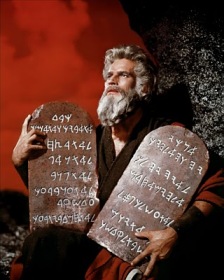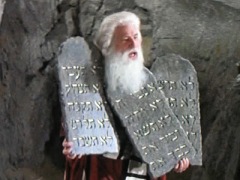When thinking of Moses and the 10 Commandments usually one of two pictures comes to mind. The first is that of Charlton Heston bringing the two tablets down from the mountain in epic fashion. The other, for some, is that of Mel Brooks carrying the three tablets down only to drop one bringing the total from 15 commandments to only 10.


Whichever picture you have in your mind, no doubt the first tablet has commandments 1-5 and the second has 6-10. Is that what they really would have looked like? What can we tell from the text of the Bible and from contemporary sources?
And he gave to Moses, when he had finished speaking with him on Mount Sinai, the two tablets of the testimony, tablets of stone, written with the finger of God.
– Exodus 31:18Then Moses turned and went down from the mountain with the two tablets of the testimony in his hand, tablets that were written on both sides; on the front and on the back they were written.
– Exodus 32:15
Split Commandments or Two Copies
Jewish tradition is split (ha) on the issue.
In the Mekhilta of Rabbi Ishmael (Tractate de-ba-Hodesh 5) we read: “How were the Ten Commandments given? Five on one tablet and five on the other. ‘I am the Lord’ written across from ‘You shall not murder’… This is according to R. Hanina b. Gamaliel, but the Sages say ten on one tablet and ten on the other” (Horowitz-Rabin ed., p. 233, and parallel versions listed there). The second opinion, that of the Sages, essentially means that the Ten Commandments were given in double form. There we also find a tradition of the first commandment being juxtaposed to the sixth, the second to the seventh, etc. These two traditions are maintained in Midrash Rabbah on Exodus, sec. 47.6, where the same controversy is ascribed to the Amoraim, R. Judah (arguing for five on each) and R. Nehemiah (saying there were ten on each). It should be noted that in both these midrashim and in parallel versions, no exegetical explanation of the Biblical text is given in favor of one or the other arrangement of the Ten Commandments.
– “What was written on the two tablets?” Dr. Meshulam Margaliot, Bar Ilan University, July 2004.
All of us picture two tablets with five commandments each and Margaliot makes the point that this division “is very ancient and has appeared in Jewish art for centuries.” On the theology side, many have raised the issue that the first four (or five) commandments are different from the rest and therefore there are “two tablets” in classification.
We ought to ponder what the division of the divine law into two Tables meant. This is impressively mentioned at various times with good reason, as all sane men will agree. And there is a ready reason for us not to remain uncertain on this matter. God has so divided his law into two parts, which contain the whole of righteousness, as to assign the first part to those duties of religion which particularly concern the worship of his majesty; the second, to the duties of love that have to do with men.
– John Calvin, Institutes 2.8.11
It is true that there are two distinct realms of the Decalogue, as it were. Consider the list:
The First “Table”
1. You shall have no other gods before me.
2. You shall not make for yourself a carved image.
3. You shall not take the name of the LORD your God in vain.
4. Remember the Sabbath day, to keep it holy.
The Second “Table”
5. Honor your father and your mother.
6. You shall not murder.
7. You shall not commit adultery.
8. You shall not steal.
9. You shall not bear false witness against your neighbor.
10. You shall not covet.
There is a line of demarcation between these two “tables” and it is altogether right for people to talk about this distinction. There are rules for relating to God and rules for relating to others. That is what theologians like Calvin are thinking about when they talk about the “The Two Tables of the Moral Law.”
What Calvin didn’t know
Whenever I’m thinking about the events of Exodus or the text of the Torah itself I have to remember the Egyptian influence. Moses was educated in Egypt by Egyptians and the children of Israel only knew Egypt. I think any discussion on the form of the text has to be compared and contrasted with what we know of Egyptian forms.
Margaliot points out that the closest parallel to the tablets of the Law is the covenant between the Egyptian Pharaoh Ramses II and the Hittite King Hattusilis III, c. 1270 BC. The peace agreement, commonly called the Treaty of Kadesh, was made into two tablets. The Egyptian copy was made on a tablet of silver and then copied on to the walls of the Ramses’ mortuary temple in Thebes. The Hittite copy was taken to their capital city and has since been discovered. Here is a quote from the archaeologist Hugo Winckler upon this discovery:
One glance at it and all the achievement of my life faded into insignificance. Here it was – something I might have jokingly called a gift from the fairies. Here it was: Ramses writing to Hattusilis about their joint treaty … confirmation that the famous treaty which we knew from the version carved on the temple walls at Karnak might also be illuminated from the other wise. Ramses is identified by his royal titles and pedigree exactly as in the Karnak text of the treaty; Hattusilis is described in the same way – the content is identical, word for word with parts of the Egyptian version [and] written in beautiful cuneiform and excellent Babylonian …

The remaining Egyptian copy.

The Hittite copy of the Treaty of Kadesh
From the evidence of Ancient Near Eastern covenant documents, such as the Treaty of Kadesh, it seems more likely that the “two tablets” were in fact two copies of the law. It was then customary that one copy went to the governing body and the other to the subject, otherwise known as the suzerain and vassal. In God’s covenant with Israel, he was the suzerain and the people were the vassal. Therefore one copy was to go with God and the other to be placed in the temple of the people. For the ancient Israelites the presence of God and their temple was in fact the same place, the Ark of the Covenant.
“At that time the Lord said to me, ‘Cut for yourself two tablets of stone like the first, and come up to me on the mountain and make an ark of wood. And I will write on the tablets the words that were on the first tablets that you broke, and you shall put them in the ark.’ So I made an ark of acacia wood, and cut two tablets of stone like the first, and went up the mountain with the two tablets in my hand. And he wrote on the tablets, in the same writing as before, the Ten Commandments that the Lord had spoken to you on the mountain out of the midst of the fire son the day of the assembly. And the Lord gave them to me. Then I turned and came down from the mountain and put the tablets in the ark that I had made. And there they are, as the Lord commanded me.”
– Deuteronomy 10:1-5
Therefore, I believe the proper understanding of the tablets is that there were two identical copies made. Each was placed in the Ark representing both God’s presence and the Israelite’s temple.